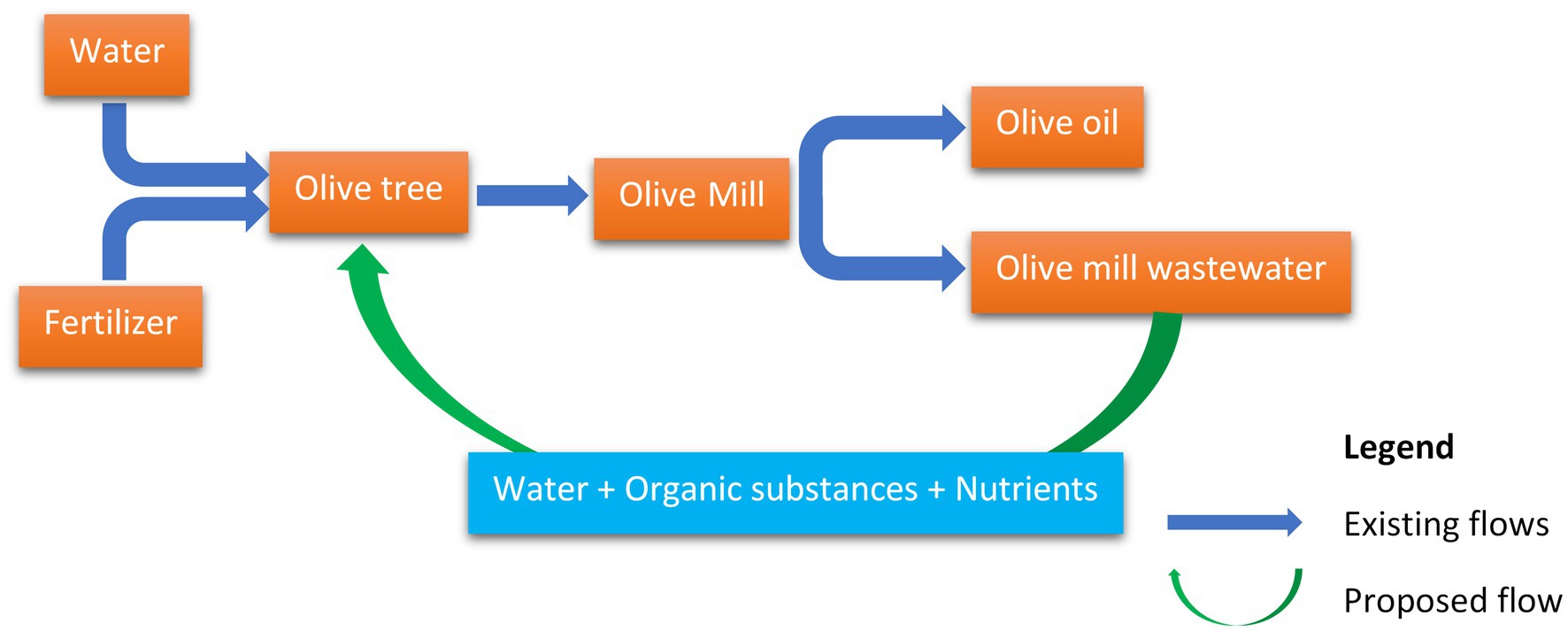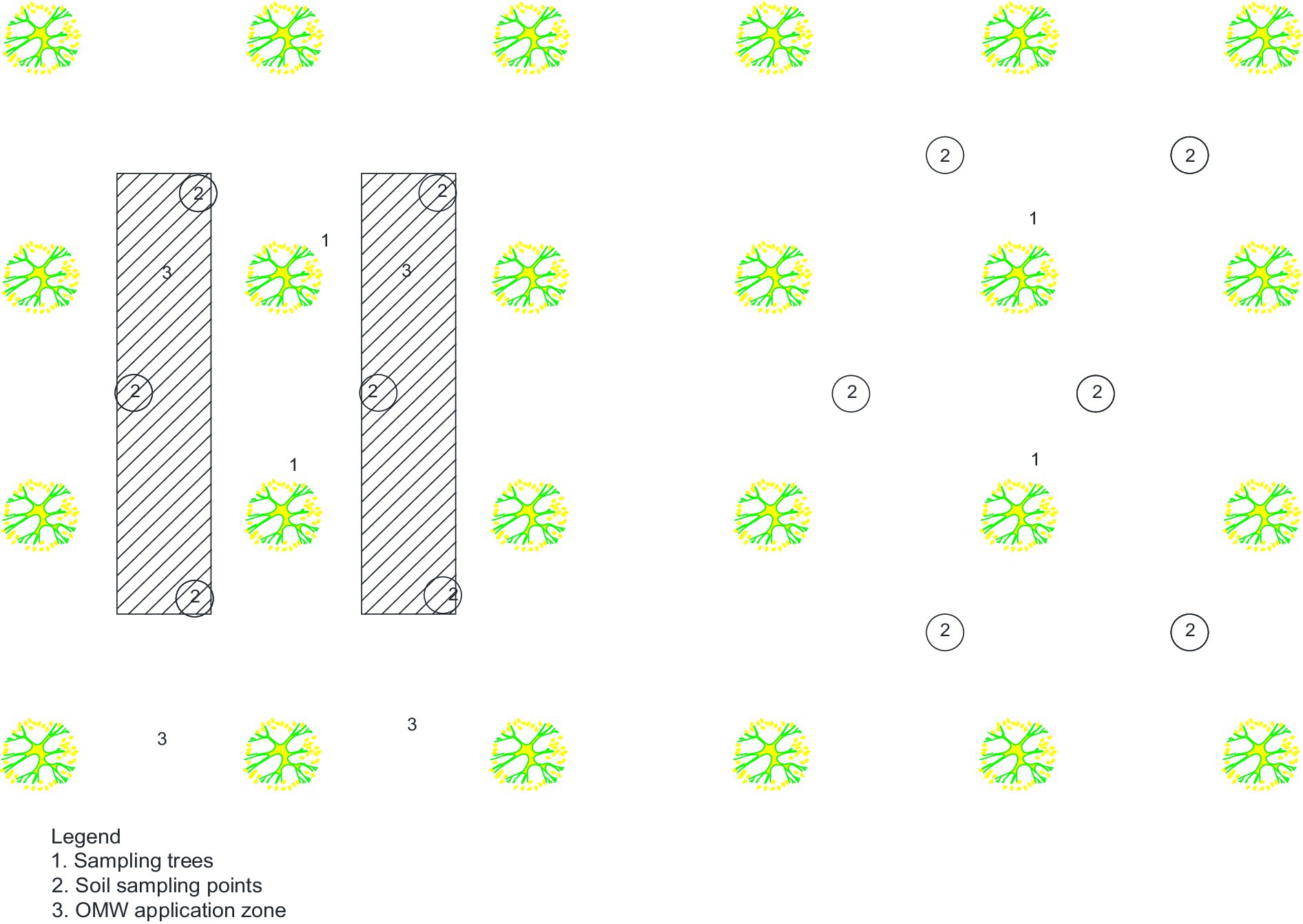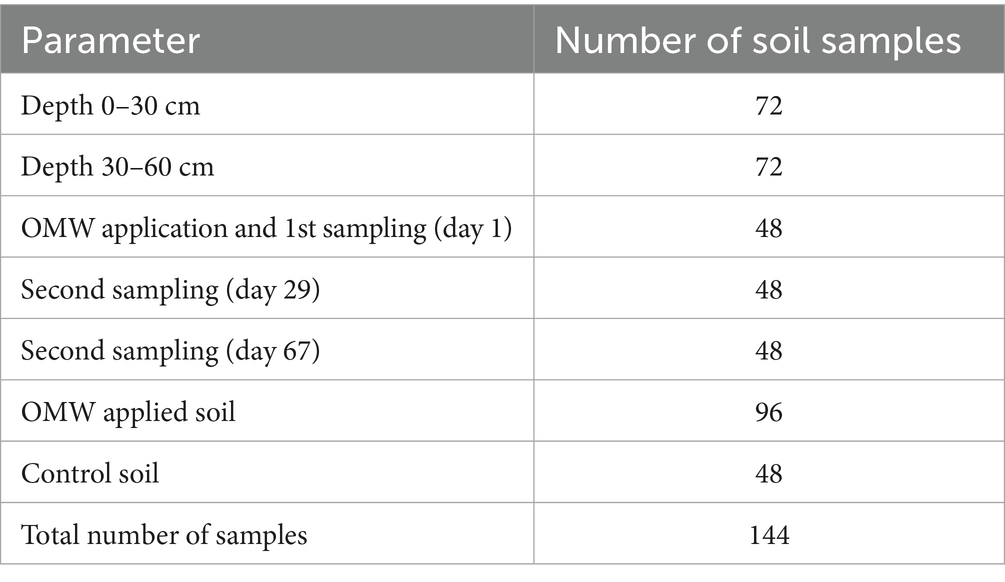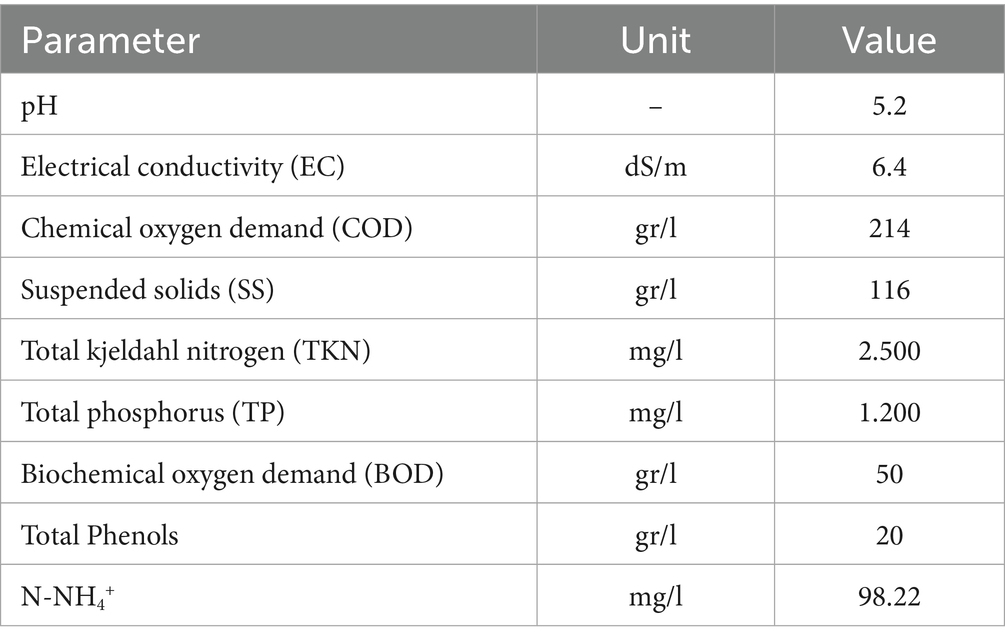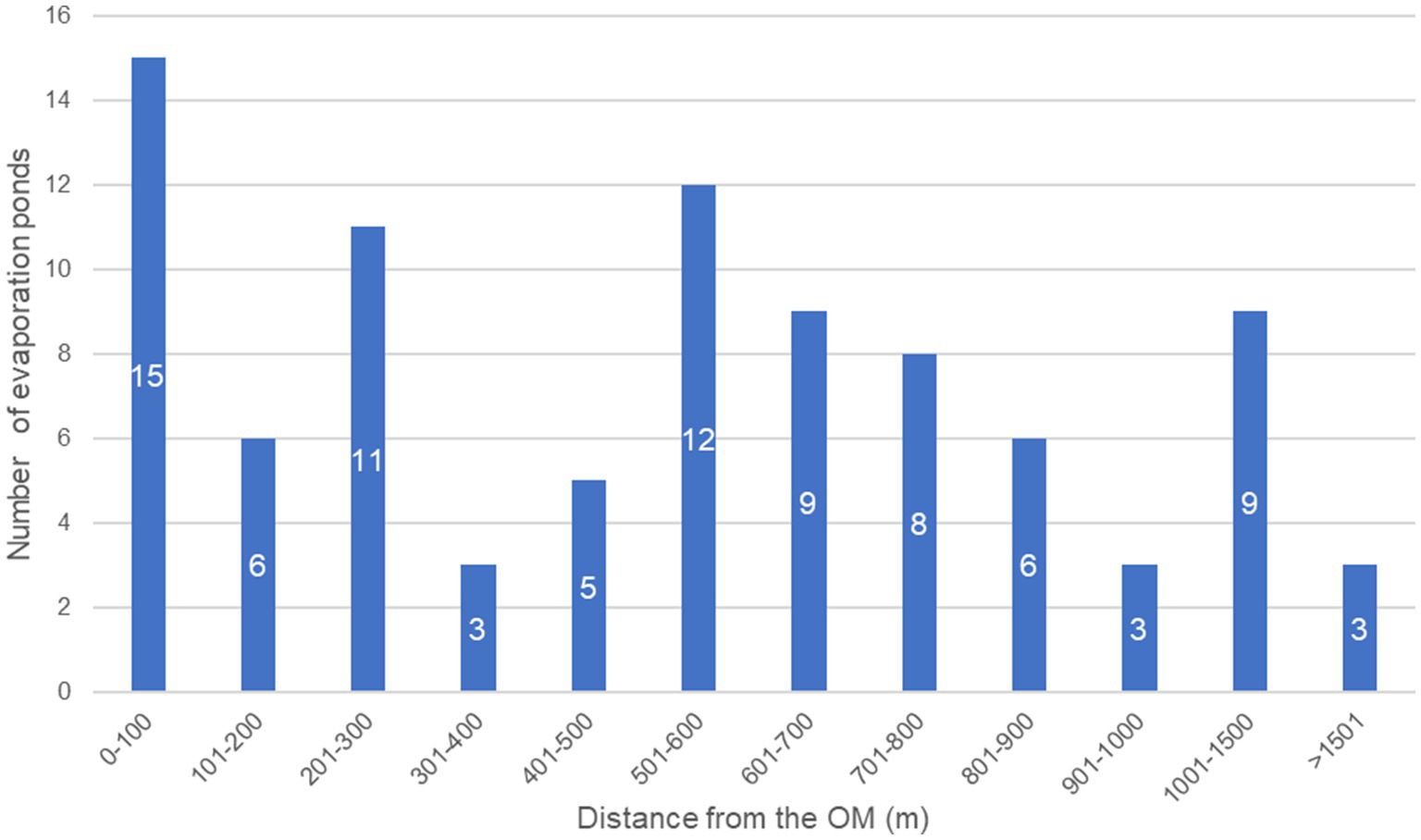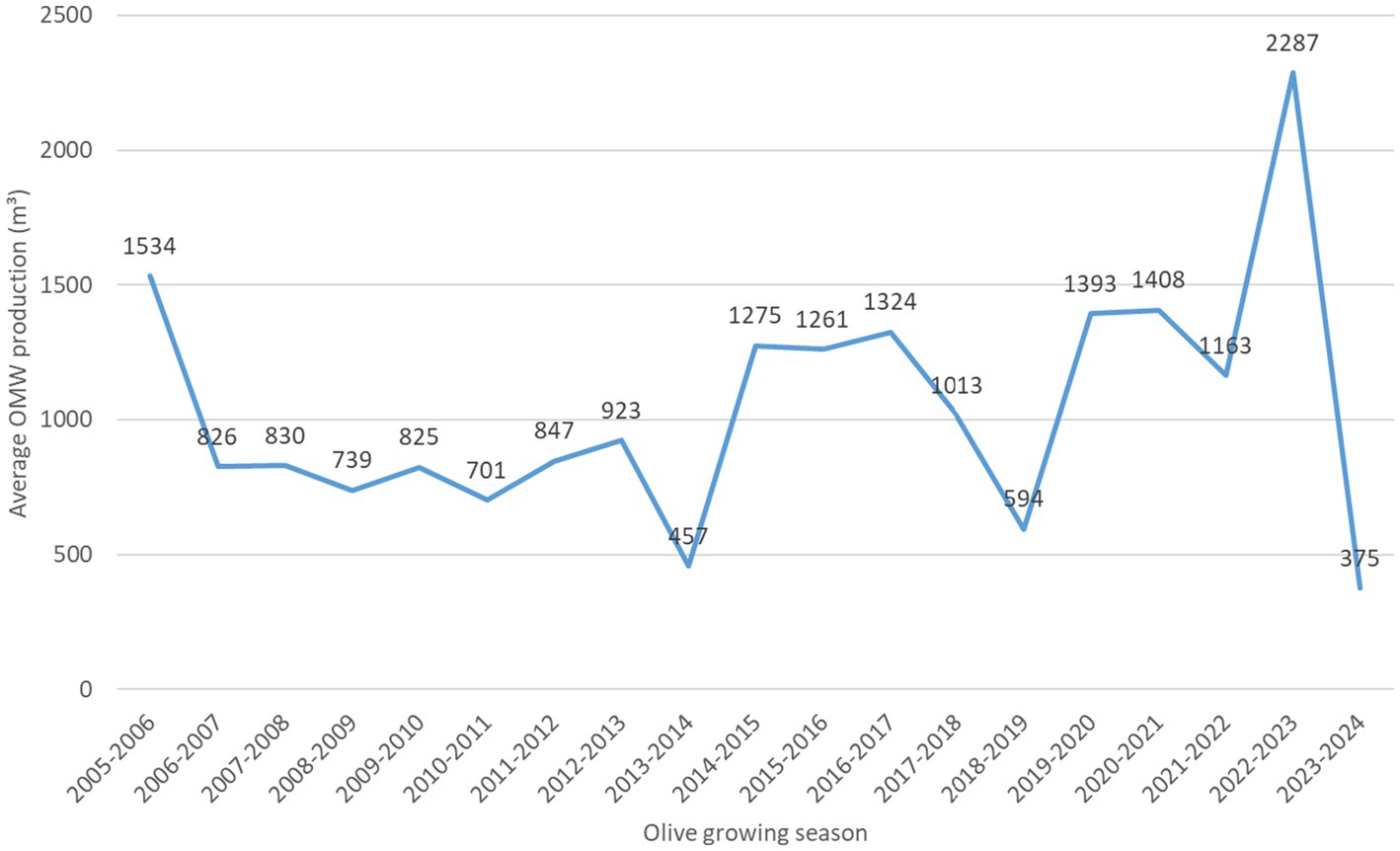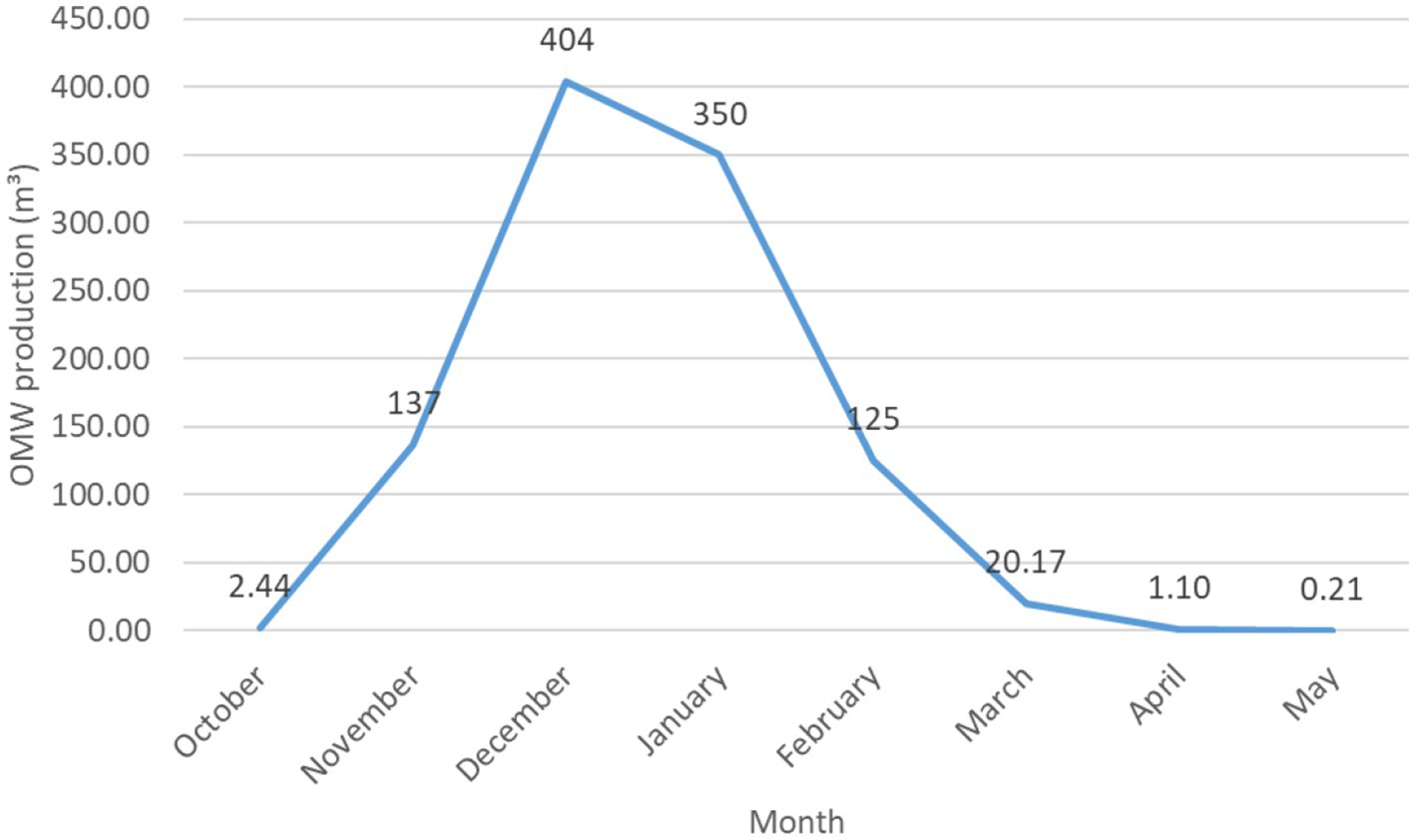- 1Department of Civil Engineering, School of Architecture, Engineering, Land and Environmental Sciences, Neapolis University Pafos, Pafos, Cyprus
- 2Department of Agriculture, School of Agricultural Sciences, Hellenic Mediterranean University, Heraklion, Greece
Olive mill wastewater (OMW) is the most important aqueous by-product generated during olive oil extraction from olive fruit. Due to the large quantities produced in short periods, OMW exhibits high phytotoxicity and a high level of organic pollution, which presents a serious environmental concern. There are two approaches to effectively managing OMW and its impacts. The first one concerns treatment, which involves a combination of physical, chemical, and biological processes adopted within a specific and predetermined framework. The second one concerns land treatment, which dates back to Minoan times and is based completely on natural processes. This, as adopted in the modern era and favored by the enforced legal framework of various olive oil-producing countries, refers to high loading rates of pretreated OMW and aims to assess soil treatment potential and address future environmental impacts. However, despite its environmental benefits, this approach is not entirely consistent with the principles of the circular economy (CE). In contrast, direct application of untreated OMW to the orchards that generate it, immediately after production, is considered promising and ensures the sustainability and adoption of CE principles through reuse. For this reason, a holistic approach to OMW management was adopted, covering all stages of OMW, from production to application, with minimal impact. The purpose of this study was to (a) investigate and evaluate current by-product management techniques in the Messara basin, Crete, an area highly affected by increased OMW quantities, and (b) assess the short-term effect of OMW land application on soil properties. Analysis of the results indicates that current management practices lack efficiency, causing severe environmental impacts; the enforced legal framework concerning land application cannot be fully adopted. In contrast, OMW land application onto olive orchards directly after production does not cause, as expected considering the literature, any adverse effects on soil properties; instead, it increases nutrient availability and maintains soil organic matter (SOM). Along with the soil effects, the present study provided practical information and guidance on OMW application rate and timing to facilitate farmers, policymakers, and decision-makers. Overall, the findings of the study suggest that direct land application should be considered as an alternative solution to effectively manage the negative impacts of by-products. This is fully consistent with the basic CE principles, climate change adaptation, and established Sustainable Development Goals (SDGs).
1 Introduction
Globally, the continuous increase of olive oil production, approximately 5% per year (Mohawesh et al., 2019) results in a subsequent continuous increase in the generation of various olive oil by-products and mainly in olive mill wastewater (OMW), the aqueous by-product generated during the processing of olive fruit for olive oil production. This is most evident in the Mediterranean region, where the majority of olive oil is produced. Indicatively, in the 2019–2020 crop year, olive oil production accounted for 90.02% of world production (2,940·103t out of 3,266·103t) (IOOC, 2023). However, it is difficult to accurately calculate the total volume of OMW produced worldwide, as it depends on many parameters, except the produced olive oil volume, such as by-product management practices, compliance with the applicable legal guidelines, water availability, and olive oil extraction process (Kapellakis et al., 2008; Halalsheh et al., 2021). Approximations ranging from 5,400 (Fleyfel et al., 2022) or 6,000 (Lanza et al., 2017; Foti et al., 2021) to 9,700 × 103 ton worldwide, or up to 30,000·103 ton for the Mediterranean region (Chiavola et al., 2014). In any case, OMW poses a serious environmental concern as it is a phytotoxic by-product characterized by high pollution potential related to high content of salts, organic matter, and phenolic compounds, and a pH between 4 and 5.5, while it is produced in significant quantities in a short period during harvest (Chaari et al., 2015; Rusan et al., 2016; Souilem et al., 2017).
To mitigate this situation and to achieve a reduction of the generated volumes, a change in the operating regime has been adopted in recent years: in Spain mainly and less in other countries, the olive mills (OM) have adopted the two-phase system of olive oil production process (Sanchez-Sanchez et al., 2020). This system does not require the addition of water during the process, except for the final separation with horizontal centrifugation, and produces two distinct products: olive oil and a semi-aqueous, semi-solid olive cake (slurry pomace) with a moisture content of approximately 65%. This conversion has been favored by the OMs that are large enterprises; therefore, the expensive management of the slurry pomace produced can be profitably covered. However, in countries such as Greece, OMs are mainly family-owned, small-scale private enterprises; therefore, management of the slurry pomace is not an economically viable solution. For this reason, the main olive oil production process is the three-phase system (olive oil, OMW, and olive pomace), which requires the addition of water and favors the production of large quantities of OMW (approximately 5 m3 OMW/ton of olive oil). The olive pomace is transported to central olive pomace factories, while the OMW is managed through a treatment system imposed by the Joint Ministerial Decision (1965) (JMD) Eib 221/65 (Official Government Gazette (OGG) 138/Β/24-02-1965) and is associated with the most common management method, often legally adopted: Lime addition and disposal of the OMW in evaporation ponds (Mohawesh et al., 2020; Sáez et al., 2021), a low-cost practice associated however with the development of odors, OMW leakage into surface waterways or groundwater and relatively high area requirements in regions with low ET0 rates (Kapellakis et al., 2012; Kavvadias et al., 2015) (Figure 1).
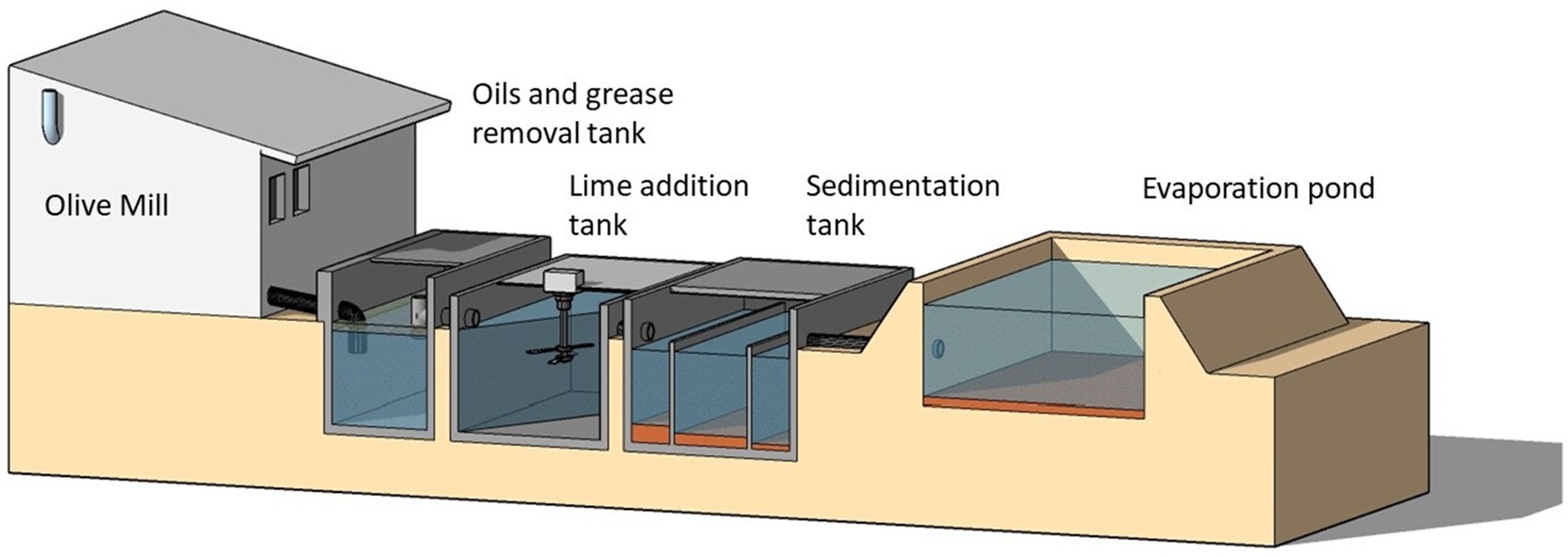
Figure 1. Flow diagram of the OMW management scheme (not to scale) (Kapellakis and Tsagarakis, 2024).
To date, a large number of different solutions and technologies have been proposed and adopted for OMW treatment, based on either conventional (e.g., industrial, biological, and physicochemical) or natural treatment methods, where high and usually repeated organic loading rates are applied to the land treatment systems, with each approach having its own advantages and disadvantages. Regarding the controlled land application, different amounts of OMW have been applied to various crops at different time periods. For instance, Lanza et al. (2017) have applied different amounts (0, 5, 10, and 30 L/m2) of OMW for 9 years consecutively on soil cultivated with olive trees, Chaari et al. (2015) have applied three OMW doses (50, 100, and 200 m3/ha·year) for nine successive years, while Ayoub et al. (2014) have applied five OMW doses (0, 5, 10, 20, and 4 × 20 L/m2) in an olive orchard. Legal framework of the main olive oil-producing countries favors land application: in Italy, according to Law 574/96 the maximum tolerance limit for soils is set to 50 m3/ha·year and 80 m3/ha·year for OMW derived from pressure and three-phase systems, respectively, while in Portugal according to Law No. 626/2000 the maximum limit for soils is set to 80 m3/ha·year for spreading OMW on agricultural lands (Koutsos et al., 2018). In Spain, the maximum volume of effluent to be applied to agricultural land should not exceed 50 m3/ha·year (Inglezakis et al., 2012). Ιn Greece, according to the Joint Ministerial Decision 135207/1801 (2017), the maximum applied volume is set to 20 m3/ha·year for olive groves and other tree crops, excluding citrus orchards.
A common characteristic of all these studies and legal frameworks is that loading rates in controlled land application refer mainly to pretreated OMW quantities derived from larger areas than the plots of land applied. However, one may argue that this approach is not in full agreement with the principles of CE, which “aims to reduce waste and conserve resources by recycling and reusing products and components and closing resource, material, and energy loops” (Donner et al., 2022). The present study supports the concept of reusing the OMW produced in the olive orchards, considering a closed-loop recycling approach in which “the wastewater produced by an olive tree during its olive fruit processing should return directly to that olive tree” (Figure 2). This idea is fully compliant with the principles of circular economy (CE) and with the specific Sustainable Development Goals (SDGs) established for olive oil-producing countries like the Mediterranean regions. We hypothesize that the direct controlled OMW application will improve the soils of olive orchards, without causing negative impacts on the olive trees, soil properties, and the environment, while improving the economic performance of olive production and facilitating adaptation to climate change’s challenging conditions. Such a practice will require specific guidelines and field practice protocols to support policies that will further expand its application to olive-growing areas. Based on above, the specific objectives of the present study are (a) to investigate the current management techniques and evaluate their performance in terms of their adoption by the OMs and, (b) to investigate the OMW potential effects on soil properties, focusing on preservation of soil organic carbon and nutrients, (c) to provide insights into the appropriate OMW application rate and timing,(d) to examine the CE perspective of proposed OMW application to the study area, and (e) to potential connection of this practice with existing SDGs. The findings of the present study are expected to highlight the potential benefits of the OMW application and provide insights for future research and improvements.
2 Materials and methods
2.1 Survey
The survey took place in the Messara Plain, Crete, Greece (35°01′N, 24°49′E) between 2001 and 2024. It records the existing situation and trends, while the findings were filtered and evaluated in the light of the CE concept. The collected data from the onsite visits to the OM stem from: (a) information given by the staff and management of OMs, (b) available design data of the OMs, and (c) on-the-spot investigations. It included OM tracking, information on leaf management and washing wastewater management, treatment unit and evaporation pond sizing and monitoring, and estimation of the average OMW per OM by olive oil production.
Due to the Regulation (European Union (EU)) 2016/679 of the European Parliament on the protection of natural persons with regard to the processing of personal data and on the free movement of such data, and repealing Directive 95/46/EC (General Data Protection Regulation), no data were available on olive oil production per individual OM. For this reason, the data provided by the competent authorities are related to the total of OMs. These data were provided by a varying number of OMs each year and were integrated into the total OMs. Thus, the main trends concerning management issues are reported. The location of the OMs and the evaporation ponds is shown in Figure 3.
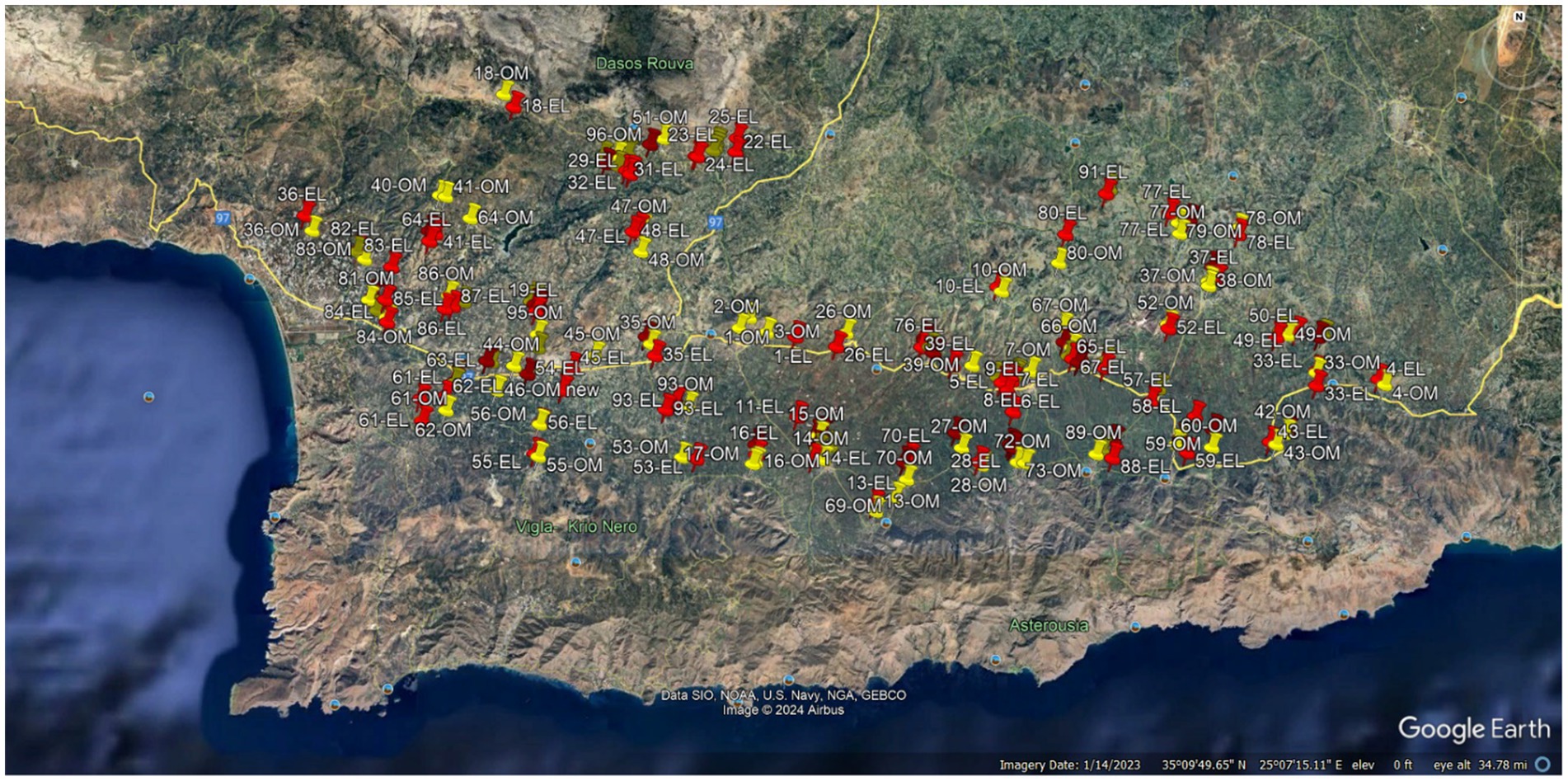
Figure 3. Location of the OMs (yellow) and the evaporation lagoons (red) in the Messara river basin.
2.2 Experimental setup
OMW was immediately transferred from a three-phase centrifugal type OMs after production and uniformly applied in eight olive orchards, between the olive tree rows (Figure 4). The orchards were located near the OMs in two agroecological zones: hilly and plain (four repetitions per zone). Olive orchards were planted at a distance of 8 m × 8 m, with cv. “Koroneiki,” 25–30-year-old trees. Trees were healthy and properly managed in terms of canopy management, trained in an open-center system. The immediate application was chosen/selected to avoid the phenomenon of polymerization of phenols, which results in the production of phenolic compounds that are not readily biodegradable (Assas et al., 2002; Ayed et al., 2005; Taccari and Ciani, 2011) and, on the contrary, to minimize management costs. The proximity of the olive groves to the OMs was considered to ensure that the OMW should remain homogenized to avoid potential separation between liquid and solid phases, which in turn will result in the production of toxic sediments (Sáez et al., 2021), as well as to minimize transfer costs. The location of the olive orchards with respect to the island of Crete, south of Greece, is shown in Figure 5.
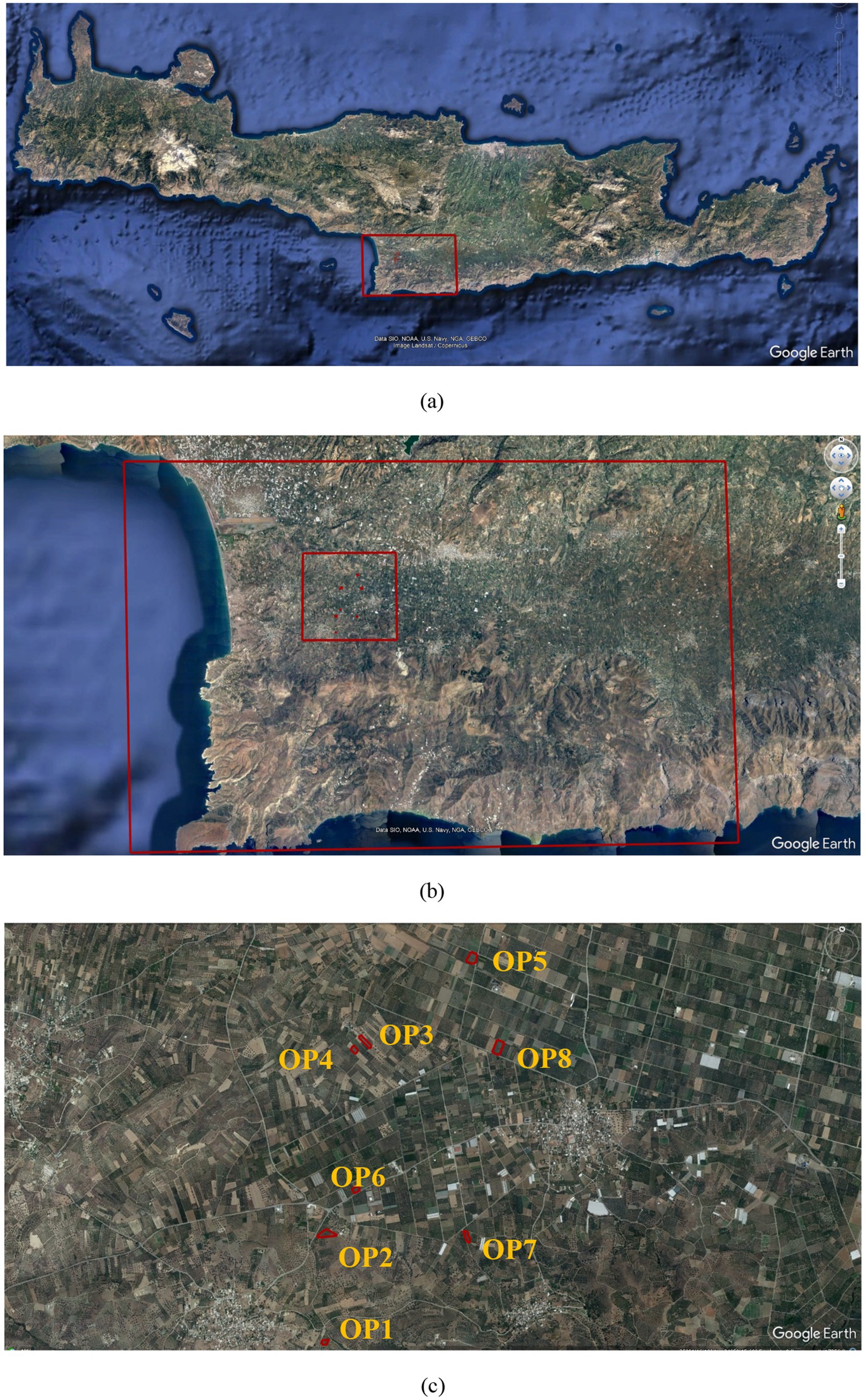
Figure 5. (a) The Messara river basin with respect to the island of Crete, (b) the case-study area in the western part of the Messara river basin, and (c) location of the eight olive plots.
As the purpose of the study is the CE’s closed-loop approach “the by-product produced by an olive tree during its olive processing should return directly to the olive tree,” the quantity of OMW applied per orchard/block of olive grove corresponds to the quantity of OMW produced by the olives of the olive orchard of the corresponding area. In the Messara Plain, an average ratio from three-phase centrifugal type OMs between olive oil and OMW is 1:5, and an average amount of olive oil produced by an olive tree is 10:l, thus the application was set to 50:l of OMW per olive tree, corresponding to 10 m3/ha/year.
Four olive trees were selected in the middle of each of the eight olive groves (Figure 5). In an area of 25 m2 located between 4 olive trees and at a distance of 2 m from their trunks, 200:l of fresh OMW were uniformly applied. Following the above-mentioned ratio, 48 soil samples were collected from the 8 olive groves in three repetitions: 1 day after, 1 month after, and 2 months after OMW land application, totaling 144 soil samples. From each of the eight olive groves, two samples were collected at a depth of 0–30 cm and two at a depth of 30–60 cm from the OMW application area, as well as one sample from each depth from a control area (Table 1). A typical layout of the area of application, the sampling trees, and the soil sampling points is shown in Figure 4.
A quantity of 0.5 L of OMW was collected at the start, in the middle, and at the end of OMW application in the eight olive orchards. It was then mixed and shaken, resulting in one homogeneous sample of 1.5 L representing the OMW applied. Preparation and analyses of the sample were carried out according to the Standard Methods for the Examination of Water and Wastewater (APHA, AWWA, WEF, 1995). There was very small variability in the OMW composition. The average composition of the OMW applied is presented in Table 2.
2.3 Soil analysis
Soil texture analysis was performed using the Bouyoucos method (Bouyoucos, 1962), using a 10% sodium hexametaphosphate as the dispersing agent during the analysis (Mwendwa, 2022), and the results are presented in Table 3. Soil samples, after being air-dried in an oven, were ground with a mortar and sieved through a 2-mm hole diameter sieve. For soil texture analysis, soil pH and EC, nitrate nitrogen (NO3-N), ammonium nitrogen (NH4-N), and soluble potassium (K) and phosphorus (P), the saturation paste method was applied (Rhoades, 1982; Keeney and Nelson, 1982; Knudsen et al., 1982). For the photometric needs of the laboratory analyses of the above parameters, a portable Macherey–Nagel photometer model PF3 was used. Nitrate concentration was measured at a 365-nm wavelength with 2,6-dimethylphenol in sulfuric acid/phosphoric acid mixture. Ammonium concentration was measured at 690-nm wavelength as indophenol. At pH 12.6, ammonia reacts with hypochlorite and salicylate, catalyzed by Na2[Fe(CN)5NO], to form blue indophenol. Potassium concentration was measured at 690-nm wavelength by measuring turbidity as C24H20BK. Total Phosphorus Reagant 2-No need for expansion Reagents are made from the same company, Macherey Nagel was also measured at 690-nm wavelength after burning a sample with reagent (TP R2) and adding reagents TP R3 and TP R4 from the above company. The soil organic matter (SOM) was measured, using the Walkley–Black method, based on organic carbon oxidation by potassium dichromate (Tsitsias, 1987; FAO, 2020).
2.4 Statistical analysis
The collected data were statistically analyzed using SPSS version 20.0 (IBM Corp, 2011) to examine the effect of the three factors: Sampling period, depth, and OMW application. Specifically, univariate analysis was performed, and data were assessed for normality using the Shapiro–Wilk test (p < 0.05). The data were found to be non-normally distributed, even after several transformations. Therefore, the non-parametric Kruskal–Wallis and Mann–Whitney tests were used to determine whether the differences between sampling periods—three-category comparison (Kruskal–Wallis test) and between depth and implementation of OMW—two-category comparison (Mann–Whitney) were important. Significance was reported at the p < 0.05 level.
3 Results
3.1 Survey
Approximately 92 OMs are currently operating in the Messara basin, Crete -their exact number cannot be verified by the local authorities. The majority of the OMs (79) are located in the plain area, where most olive trees are cultivated, compared to the rest, which are located in the hilly areas on the north side of the basin. To operate, all these OMs are required to manage OMW in accordance with the provisions set by the aforementioned JMD Eib 221/65, as illustrated in Figure 1, while the majority of the OMs have been granted a permanent OMW management license by the local authorities and includes their disposal onto evaporation ponds. The new OMs are required to comply with the Joint Ministerial Decision 127402/1487/15 (2016) (OGG 3924/Β/07-12-2016), which inherits in general the provisions of the JMD Eib 221/65 and specializes the treatment process as OMW should undergo pretreatment, which includes oils and grease collection and sedimentation with a minimum of 3-h retention time and neutralization with the addition of at least 5 kg of CaO per ton of olive fruit processed, while it also provides guidelines on the optimum location of the evaporation ponds (Kapellakis and Tsagarakis, 2024).
Leaf production is approximately 100 ton/year per OM. Despite being a by-product of the olive oil production process and OM staff do not have any particular utilization plan, leaves are broadly collected by shepherds who use them to feed animals, while in small quantities, they are used as fertilizer, mainly in olive orchards. In general, management techniques of leaves are not considered a threat to the environment, and this is favored by the legal framework, which promotes this type of management (OGG 1275/B/11-04-2012) (Joint Ministerial Decision 15/4187/266, 2012).
Approximately 120 m3 of washing wastewater is produced on average per OM during the olive harvest season, with a production ranging from 10 to 1,680 L/day. This wastewater is less polluted than the OMW produced during the extraction process. However, as they are used to wash the twigs, dust, and leaves from the olives, they turn brown and are then usually disposed of into the evaporation ponds. This impacts the increase in the total wastewater quantity stored in evaporation ponds, which can cause overflow, especially during periods of heavy rainfall. In contrast, considering the quality and quantity of this wastewater, one can assume that its possible disposal into rivers, creeks, and sewers, where feasible, or application to agricultural lands, such as olive orchards and vineyards, should be considered, provided it does not cause significant environmental effects.
In contrast to washing water management, the situation during malaxation and centrifugation is entirely different. The quantity of washing water largely depends on the origin of water and the purity of the olive seeds, while in malaxation and centrifugation, these distinctions are obliterated, due to the significance of this step. Water is added to the olive paste during malaxation in such a quantity to increase the percentage of available oil that can be separated and collected during centrifugation. On average, 1,041 m3 OMW/year are produced per OM. This quantity varies among the OMs and depends on the number of production lines of the OMs, which ranged from 1 to 3, the capacity of the OMs, which varies from 2 to 8.4 ton/h, the olive variety, and the climatic conditions.
The level of treatment is considered the same for all the Oms. Due to their limited performance (Kapellakis et al., 2006) and the lack of specialized staff, treatment units are often not in operation, and the OMW is disposed of untreated directly into the evaporation pond. The excavation depth and, therefore, the embankment height were dependent on the area of the pond and the volume of OMW.
Compared to other methods proposed for OMW management, evaporation ponds are considered low-cost solutions. However, they pose a high risk of leakage from both the long transfer pipes and the embankment sides. Efficient use of ponds results in solid sedimentation and subsequent removal and disposal of sediment sludge by the end of the summer. Removal of sludge is a problem, as, apart from the economic cost, it is difficult to manage properly without causing public complaints.
Olive pomace production is estimated to be 500 tons per OM per olive harvest season, with a production range of 40 to 6,735 kg/day. Due to their content, once adequate quantities are produced, they are sold and transported to olive pomace factories for further processing.
An analysis of the geometrical characteristics of the treatment units and the evaporation ponds is presented in Table 3, while the number of evaporation ponds according to their distance from the OM is presented in Figure 6. The high standard deviations reveal that the values are not close to the mean but are spread out over a wider range. This can be explained by the fact that there is no specific rule in site selection, except those mentioned before. Indeed, the evaporation ponds were constructed either on OM properties or in isolated plots that were economically feasible to buy and had less social backlash. Therefore, factors such as subsoil quality, microclimate conditions, and the topography of the surrounding area were not considered in the site selection. Figure 7 presents the average annual OMW production per OM, which was calculated indirectly by the olive oil production. Note that production for 2024 is limited up to January 2024, where data was available. Figure 8 presents the average monthly variations in OMW production.
3.2 Field experiment
The results of the soil texture analysis in the olive orchards are presented in Table 4. The olive orchard soil types were varied. Most of the soils were characterized as intermediate-texture soils. The pH shows a downward trend between the first and second sampling, while it increases slightly in the third. Comparison of the measurements showed that there were statistically significant differences of pH values between the three sampling periods (p = 0.05) (Figure 9a), but not between depths (p = 0.979) (Figure 10a). In the EC, an increasing and scattered trend is observed between the first and second sampling, while it decreases in the third (Figure 9b). The statistical comparison showed that there were statistically significant differences both between the three sampling periods (p = 0.000) and two sampling depths (p = 0.000); higher values were found in surface/topsoil (Figure 10b). The concentrations of SOM show low and not statistically significant variations between the periods (Figure 9c), while the statistical comparison showed that there were statistically significant differences between the two sampling depths (p = 0.000) (Figure 10c). The highest SOM values were observed on topsoil/surface soils. Low values in phosphates, potassium, and ammonium were detected, reflecting the measurements on the soluble part of these nutrients. The concentration of phosphates fluctuates at very low levels, while the sampling period appears to be statistically significant (p = 0.000), showing the lower values at last sampling (Figure 9d). The differences between soil layers were insignificant (Figure 10d). Regarding potassium, an increasing trend is observed in the second sampling and a slightly reduced concentration on the third (p = 0.000) (Figure 9e). Also, a significant difference is observed in the two different depths, with the highest values in the upper soil layer (p = 0.000) (Figure 10e). In ammonia concentrations, statistically significant differences as regards to the impact of application are observed. In the second sampling, a significant increase is observed, while in the third, all concentrations tend toward the initial values (p = 0.000) (Figure 9f). The effect of depth was insignificant (Figure 10f). Regarding the nitrates, their concentration increases significantly in the second sampling and decreases in the last one (p = 0.000) (Figure 9g). Statistical comparison showed that there were statistically significant differences between the two sampling depths, showing higher values for the upper than deeper soil (p = 0.024) (Figure 10g).
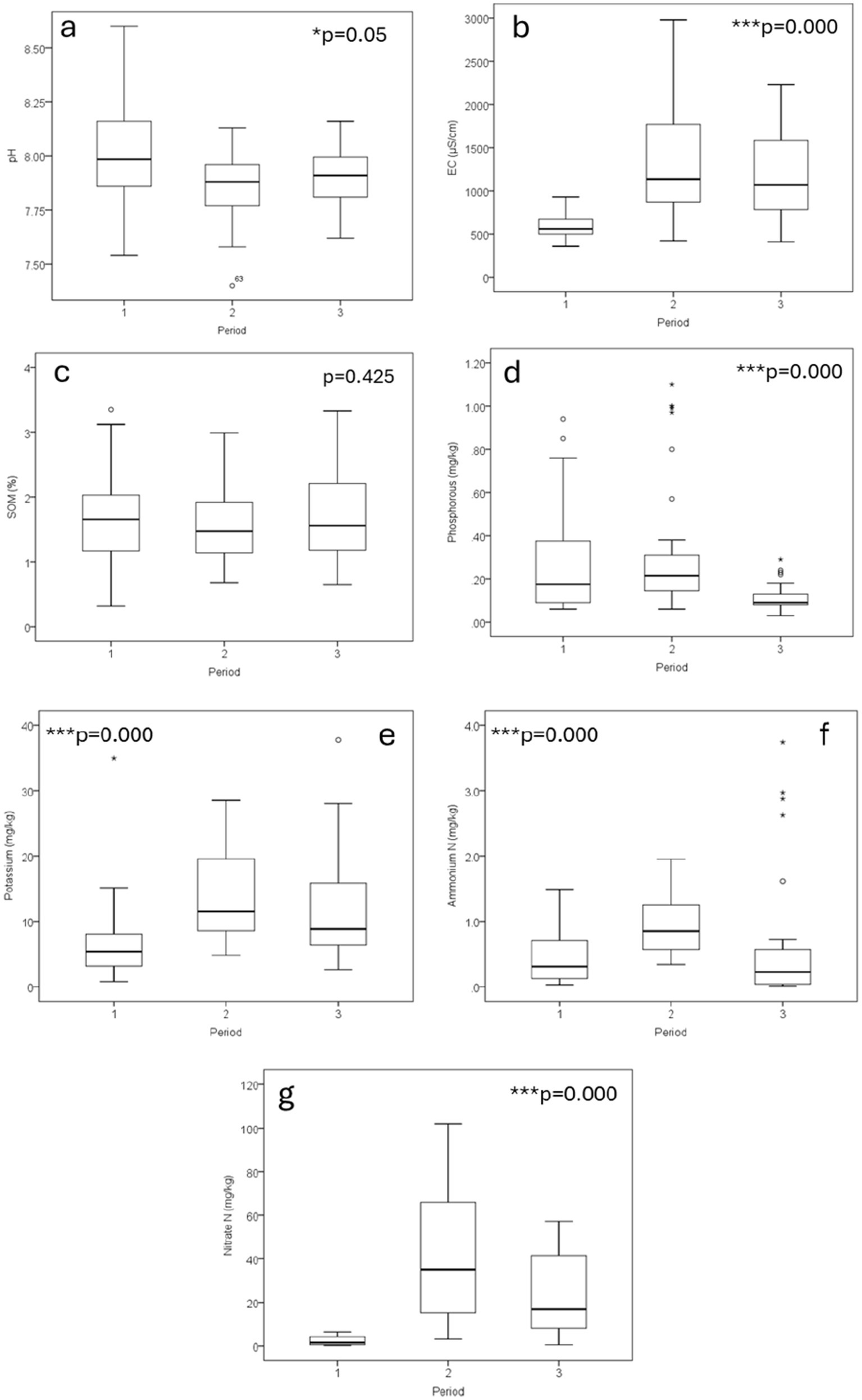
Figure 9. Boxplots of soil parameters (pH (a); EC (b); SOM (c); phosphorous (d); potassium (e); ammonium (f); and nitrate (g)) for three different sampling periods (first day (1), 29th day (2), and 67th day) (3). For comparisons between the collection periods, the non-parametric, Kruskal–Wallis test was used. *Asymptotic significance (two-sided test) at p < 0.05; **Significance at p < 0.01; ***Significance at p < 0.001.
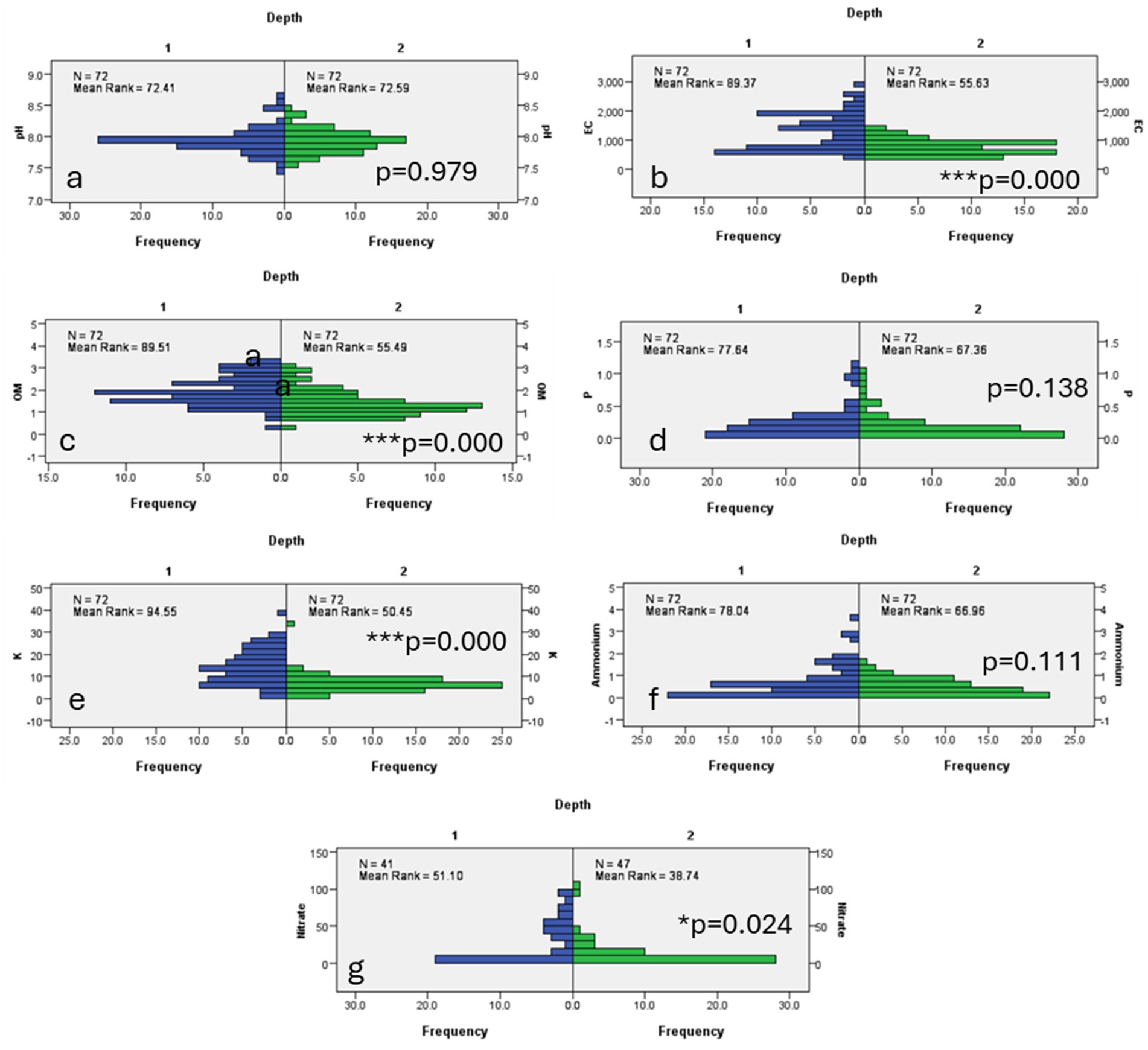
Figure 10. The impact of depth (0–30 cm (1); 30–60 cm (2)) on different soil parameters (pH (a); EC (b); SOM (c); phosphorous (d); potassium (e); ammonium (f); and nitrate (g)), based on the Mann–Whitney U test. *Significance at p < 0.05;**Significance at p < 0.01; ***Significance at p < 0.001.
4 Discussion
4.1 Case study
Greece is the third-largest olive oil-producing country in the world, after Spain and Italy. Around 430,000 tons of olive oil per year are produced annually in approximately 2,800 OMs throughout Greece, while approximately 20% of them are in Crete (ELSTAT, 2022). In general, at the country level, OMs are small and medium/family enterprises, which means that the staff employed are exclusively involved in olive oil production. Therefore, their size and capacity do not allow the recruitment of specialized staff to effectively manage OMW. Indeed, most OM owners have installed treatment units as a matter of legal pressure from the relevant authorities to obtain the permit. Therefore, the OM owners invested the minimum funds required for their construction, which proved insufficient for treatment, and in many cases, the OMW was abandoned; consequently, most of the OMW is disposed of untreated into the evaporation ponds (Kapellakis et al., 2006). The legal framework favors land application of OMW (Hellenic Government Gazette, 2017). However, even though the application quantities of 20 m3/1,000 m2 are considered low compared to other olive oil-producing countries, the characteristics of the applied OMW refer to a BOD5 and SS concentration that should be <10 and 2 mg/L, respectively, for 80% of the samples (Joint Ministerial Decision 145116/2011, 2011). Such treatment standards cannot be achieved by the imposed treatment units, even if they operate in optimal conditions. Therefore, OM staff must either continue to discharge OMW onto the evaporation ponds or modify the olive oil extraction process from three-phase to two-phase centrifugation systems to avoid OMW production. However, this conversion is expensive and results in the production of huge quantities of slurry pomace that are then difficult to transport to the processing plants. In addition, these pomaces, like OMW or other types of pomaces, can be used as soil amendment in olive groves with environmental and economic benefits (Federici et al., 2017).
There is a misunderstanding about the “property status” and the nature of OMW. Even though it is produced within the OM facilities, it is produced during the processing of the farmers’ olives. Furthermore, since OMW has distinctive characteristics that cause adverse environmental effects, it is not considered a by-product. Therefore, a misconception has prevailed that OMW is a waste material and as such does not belong to the farmers but to the OMs, who in turn have to manage it properly. This concept is also favored by the fact that OM charges 10% olive oil producers, and this percentage includes OMW management. Sediment sludge can be applied as a soil conditioner after reclamation, provided it is dewatered on drying beds or by alternative management methods. However, similar to OMW, the main drawback of this alternative management practice is the specialized pretreatment that cannot be handled by OM staff.
Therefore, there is a need to shift OMW management to more sustainable and environmentally friendly solutions, which will minimize the liability of untrained staff and maximize profit, both financially and environmentally, while also addressing the concept of water shortage. This presupposes a redefinition of the role of farmers in the OMW production process, which should include increased environmental awareness focused on actions that can be adopted. A procedure that may be favored by a possible reduction of the aforementioned 10% is also recommended. This alternative management should consider the scattered distribution of OMs in the Messara basin, the difficulties encountered during the pretreatment process, transport and disposal in the evaporation ponds, the lack of specialized staff in OMs, the limited availability of resources for monitored water resources, and the utilization of nutrients contained in OMW. In addition, it should consider the lack of efficient control by the authorities, which results in the neglect of proper management by the OM staff, while it presupposes a redefinition of the role of farmers in the OMW production process that should include increased environmental awareness with a focus on their active participation in the actions that can be adopted and the benefits that are going to arise as a motivation.
One such action could be the direct application of the OMW in their olive orchard, in collaboration with the OM staff. As already mentioned, the legal framework favors land application. Based on this, there are two issues to consider: the quantity and quality of applied OMW. An olive orchard of 1,000 m2 has approximately 25 olive trees; it produces approximately 1.25 m3 OMW with a typical composition as shown in Table 2, with a much lower quantity and much higher concentration than the imposed one, respectively.
It should be noted that the immediate distribution of OMW may not correspond to what the OMs can do in practice. This is due to logistical reasons, such as OMs’ workload, weather conditions, and labor availability among olive growers.
4.2 Field experiment
The OMW is produced in large quantities in olive oil-producing countries of the Mediterranean region, within the short period of harvesting, and its management, also due to its characteristics (Fleyfel et al., 2022), still remains a challenge. In the present study, the main idea is the direct return of OMW produced individually by each olive tree, estimated at 50 L per olive tree, corresponding to 10 m3/ha/year, comparable to previous studies (Belaqziz et al., 2016; Mohawesh et al., 2019).
This idea proposes, in fact, a zero discharge for OMW and 100% valorization in producing olive orchards. This practice is fully compatible with the CE concept, serving not only economic but also environmental goals, such as protecting resources from the OMW polluting components. The strong nature of OMW, however, requires a thorough understanding of the potential impacts on the olive agroecosystem that includes the soil–water–plant system. OMW may act as an agent of toxicity either for soil microorganisms or olive trees, risking production and environmental quality due to the spreading of specific pollutants, such as phenols and nutrients (e.g., nitrate), and having harmful effects on biodiversity (Chatzistathis and Koutsos, 2017; Mekki et al., 2006). In contrast, many benefits from OMW have been reported (Regni et al., 2017; Peri and Proietti, 2014). In the present study, besides the case study of the area, we also studied the potential impact of direct OMW application on certain soil properties, examining/focusing/emphasizing on soil pH, soil salinity, SOM, and soluble nutrients. Soil nutrients were examined with a focus on their mobile part rather than on extractable or available forms for which a plethora of findings is available, because of their potential to degrade water quality.
Based on the findings of the study the applied OMW at the applied rate of 50 L per olive tree (10 m3/ha/year) did not cause any significant change on the examined soil properties, within a 2-month period, supporting the idea of a controlled return of OMW to the olive orchard at rates similar to the OMW production. Moreover, no evidence of toxicity for the trees was macroscopically detected (data not shown). Instead, positive effects on the quantity and quality of the product were expected as mentioned above (Regni et al., 2017; Peri and Proietti, 2014). Regarding the soil properties, no change was detected in the soil pH following OMW application, indicating the buffering capacity of the soils, which is characterized by relatively high clay content (Table 3). Similarly, EC, despite temporal fluctuations, did not vary between the control and OMW-treated soil, indicating that the contributions of root uptake and leaching to the overall budget of salts. These findings agree with a previous OMW study in Crete, where three consecutive annual applications of up to 450 m3/ha per year were conducted (Chartzoulakis et al., 2010), and a similar more recent study (Kapellakis et al., 2015). Similarly, after a month of applying up to 120 m3/ha OMW, no significant change in soil pH was detected in two high clay content soils, although EC increased in the surface and deeper soil layer due to salt accumulation (Mohawesh et al., 2019). However, the salts were depleted after an 8-month period, similar to our study, and this was attributed to nutrient plant uptake. Similarly, in a different study, lower EC values were reported after a 6-month period following the OMW application (Belaqziz et al., 2016). Soil salinity in an OMW-treated soil is attributed to the addition of ions, such as sodium, nitrates, chloride, potassium, phosphates, and sulfates, produced mostly through OMW mineralization. Additionally, irrigation or precipitation, as well as plant uptake, may also contribute to their downward movement.
In our study, the addition of OMW had no effect on SOM, probably due to the activity of soil microorganisms, which was likely favored by the climatic conditions, such as increased temperature, and the adequate soil aeration (Raza et al., 2023). Indeed, rapid decomposition of phenols without accumulation in the soil was reported after subsequent applications of OMW, at a rate up to 450 m3/ha, in an olive orchard in Crete, similar to our study (Chartzoulakis et al., 2010). In literature, there are diverse findings regarding the effect of OMW on SOM, showing mostly an increase (Abboud et al., 2023; Belaqziz et al., 2016; Doula et al., 2020; Kapellakis et al., 2015; Mohawesh et al., 2019; Regni et al., 2021) or even unaffected soils (Chartzoulakis et al., 2010), dependent mainly on the OMW loading, the soil temperature and humidity conditions, and the time period of application. The increase in SOM has been attributed to the accumulation of phenolic compounds; however, it is common to degrade over time due to the co-effect of specific processes, such as biodegradation, plant uptake, and leaching, as has been found previously (Belaqziz et al., 2016; Mohawesh et al., 2019). Previous studies confirm the hypothesis of gradual OMW degradation and depletion of phenols in soil, showing enhancement of microbial biomass (Chatzistathis and Koutsos, 2017; Piotrowska et al., 2006), increase in microbial respiration due to OMW addition (Di Serio et al., 2008; Lanza et al., 2017; Mekki et al., 2006; Piotrowska et al., 2006; Tsiknia et al., 2014), increase in phenol oxidase, peroxidase and other enzyme activities (Mekki et al., 2006; Piotrowska et al., 2006; Tsiknia et al., 2014), or even changes in the composition of microbial communities (Chatzistathis and Koutsos, 2017; Karpouzas et al., 2009; Lanza et al., 2017). These data highlight the boosting effect of OMW on soil processes due to water, carbon, and nutrient supply.
The OMW application had no effect on nitrate accumulation in soil, as indicated by the similar values in the control plots. The increase in their concentration in all plots probably illustrates the mineralization of native-soil OM by microbial activity in both OMW treated and untreated soils. In the literature, findings have shown that in soils under OMW application, low levels of inorganic nitrogen occur. This is attributed to intense microbial immobilization, which is caused by the high organic carbon loading, which may prevent nitrification (Kapellakis et al., 2015). Higher nitrate values were reported in a microcosm study, similar to our findings, showing, however, a decreasing trend over time, reflecting the effect of microbial immobilization (Tsiknia et al., 2014). Authors claimed that immobilization was enhanced by increased competition for N among soil microorganisms, disabling nitrifying microorganisms due to low ammonia availability rather than toxicity (Tsiknia et al., 2014). Indeed, OMW may increase the C/N ratio up to 50, which may cause low inorganic nitrogen availability because nitrogen is limited for heterotrophic microorganisms (Barbera et al., 2013; Di Serio et al., 2008; Sierra et al., 2007). Perhaps in our study, microbial nitrogen immobilization mediated the rapid potential additional inorganic nitrogen release by OMW mineralization, explaining the similar values with the control soil, which, however, needs further investigation.
Similar to the previous parameters, the addition of OMW had no effect on soluble potassium and phosphorus, probably reflecting the adsorption capacity of soils regarding the phosphates and potassium ions. Both of them are less mobile throughout the soil profile due to retention mechanisms and may persist over time (Regni et al., 2021), or, conversely, undergo removal by plants or water (Belaqziz et al., 2016). Literature review provides a plethora of findings that demonstrate the increase in exchangeable potassium and available phosphorus, particularly on surface soil, due to OMW application (Ayoub et al., 2014; Barbera et al., 2013; Chaari et al., 2015; Chartzoulakis et al., 2010; Doula et al., 2020; Khalil et al., 2024; Lanza et al., 2017). However, the availability appears to be regulated by the OMW content, OMW loading, and the soil properties regulating soil pH and the available sorption sites onto soil particles (Chaari et al., 2015; Doula et al., 2020). In our study we expect high sorption of phosphates and potassium onto soil particles and perhaps high precipitation of phosphates due to the presence of calcium carbonate or amorphous Al and Fe oxides in alkaline soils (Bertrand et al., 2003), which probably explain the low soluble phosphate and potassium concentrations in OMW treated soils, similar to control soils. Indeed, the soluble part of the available phosphorus after three levels of OMW application (0, 100, 200, and 400 m3 ha−1 of untreated OMW) remained less affected by OMW, compared to the exchangeable phosphorus (Mekki et al., 2006). This finding is in accordance with the high sorption hypothesis onto soil particles, particularly onto the upper soil layer, described above. This finding may also illustrate the inability of the OMW to cause environmental issues due to reduced movement of phosphates or even nitrates as shown above, at least under the soil conditions of this study, promising viable valorization by crops, although potential aerial losses for available inorganic nitrogen are possible (e.g., as NH3 or N2O through volatilization or denitrification processes). These impacts need further investigation to provide a robust budget of the fate of nitrogen in soils receiving OMW, given the importance of the element for crops and their environmental and climate footprints.
4.3 Circular economic perspective of OMW, in connection with the climate crisis, ecosystem services, and sustainable development goals (SDGs)
The reuse in general transforms the linear model that ends up in large-scale disposal to the environment into a circular system, decoupling consumption and overexploitation of natural resources from adverse impacts on natural resources (Giakoumis et al., 2020). From this point of view, CE means protecting natural resources while providing sustainable production by agricultural and human activity. In contrast, CE is the leverage for economic sustainability, arising not only from the sustainability of natural resources but also from the direct economic benefits for farmers and food industry, as new products can be introduced in the production system and processing, reaching their place in the market. In fact, the CE concept connects farmers, natural resources, crop production, and markets in the scope of sustaining resource-efficient and viable agricultural production, while providing multi-level benefits in economy, resources, and environment protection, and protection of human health (Esposito et al., 2020; Velasco-Muñoz et al., 2021; Donner et al., 2022). Because of this potential, CE is highly promoted by EU and national legislation frameworks to regulate in real life imbalances in the quality of terrestrial environments due to various discharges, along with addresses in the potential deficits across the resource’s availabilities and supplies with the current and future requirement in resources, supporting in parallel the local and regional economies (EC-COM, 2014; EC-COM, 2019).
In the domain of OMW, various perspectives exist on the use of OMW ingredients by the enterprises (Carmona et al., 2023; Sanchez-Sanchez et al., 2020; Silvestri et al., 2021; Tayeh et al., 2020). It is worth noting that, based on the current applied technologies (e.g., evaporation ponds, etc.), it does not require expensive infrastructure, unlike other water reuse substrates (e.g., domestic wastewater), which only need to comply with the local demands and policy–legislative prerequisites. Conversely, the variety of terrestrial conditions and economy requires a holistic approach to governance, involving critical stakeholders (e.g., farmers, institutions, universities, authorities, policymakers, OM staff, agencies, and organizations) to achieve motivation and successful transition to CE. Site-specific solutions may be required to address the rising challenges from social structure, local economy, public perception aspects, safety and regulatory issues, and climate and environmental conditions, promoting cooperation and synergies to solve these issues. In the case of the proposed type of the OMW management the findings related to potential impacts on soil properties along with the practical guidelines to the farmers (e.g., specific OMW rates and OMW land application timing) could be used by decision and policymakers to develop appropriate strategies, guidelines and legal frameworks to support efficient, economically viable, and sustainable OMW reuse in the OMW producing areas and regions in Mediterranean basin and elsewhere.
Climate crisis, followed by prolonged water shortages in many areas of the planet (e.g., Mediterranean basin), requires the building of climate-resilient agricultural production systems. This means the development and application of efficient strategies and measures in the field, achieving complete and efficient valorization of diversifying sources of water and nutrients, such as those contained in OMW. Existing literature supports the idea of fully exploiting OMW, as discussed earlier, to support the sustainability and resiliency of agriculture. As the OMW producing areas often face increased water stress, the OMW poses as a valuable source of water, beneficial organics, and nutrients necessary to support olive production. A thorough investigation of the potential OMW management practices, including those after the OMW production (storage and transport) and valorization in the olive orchards, while considering techno-economic impact assessments based on the existing literature, infrastructure, and alternative system configurations, is necessary to provide proper management solutions for OMW. From this perspective, information included in current water management plans for river basin districts of member states of the EU could be examined to improve the valorization of the OMW in more critical areas in Crete.
A recent study on the global water reuse highlights the need to connect water reuse with ecosystem services (ES) (Tzanakakis et al., 2023). The ES concept includes the benefits provided (e.g., social, economic, environmental, climate and human health) by the function of an ecosystem (Daily, 2003; Gomes et al., 2021), such as, water storage, land productivity, carbon sequestration, nutrient cycling, asthetic value, dependent on ecosystems’ characteristics (Bolund and Hunhammar, 1999; Bennett et al., 2009). From that point of view, the proposed direct OMW management could be seen as a driver of the provided ES by regulating directly or indirectly the whole function of olive orchards, as it relates to land production, carbon sequestration, nutrient cycling, economic benefits, etc. These could be a subject of a holistic approach in the management and evaluation of OMW-receiving olive orchards, and the proposed type of OMW management. A further perspective is to study the potential links between OMW management and the established Sustainable Development Goals (SDGs) (Tzanakakis et al., 2023). Both these perspectives on ES and SDGs could be considered to provide a wider view of the impacts of the direct application of OMW in the field and constitute the basis for a valid evaluation of this practice.
Based on the description of each of the SDGs, the OMW application in olive orchards, as a promising CE practice, could relate to several SDG targets. For example, recent study connected specific CE practices with the SDG 6 (Clean Water and Sanitation), SDG 7 (Affordable and Clean Energy), SDG 8 (Decent Work and Economic Growth), SDG 12 (Responsible Consumption and Production), and SDG 15 (Life on Land) (Schroeder et al., 2019). In the case of the OMW application in olive orchards, there is no available information on this aspect. However, the OMW management in agriculture plausibly can be connected with SDG 2, referring to “End hunger, achieve food security and improved nutrition and promote sustainable agriculture,” as OMW land application can be seen as a practice supporting sustainable agriculture and food production. Another example could be the connection between the OMW management and the SDG 15 “Protect, restore and promote sustainable use of terrestrial ecosystems, sustainably manage forests, combat desertification, and halt and reverse land degradation and halt biodiversity loss” related to land management and to the potential of the OMW to improve soil properties, enhance carbon sequestration, and increase biodiversity, discussed above. Other possible connections are between the OMW management and the SDG 6 “Ensure availability and sustainable management of water and sanitation for all,” as agricultural water management is critical issue in in overall water management, and/or the SDG 13 “Take urgent action to combat climate change and its impacts” as carbon sequestration and nutrient management, via OWM land application, can affect carbon and nitrogen losses, as GHGs emissions, in agriculture under the climate change conditions, also discussed above.
5 Conclusion
The current OMW management schemes in many olive oil-producing areas lack efficiency and sustainability. The present study, addressing this deficiency, proposes the direct and controlled application of OMW (at rates similar to those of olive tree production in the orchard) to achieve 100% valorization of the OMW produced. Based on the findings of the study, this practice did not cause remarkable changes in critical soil properties examined (i.e., soil pH and salinity); instead, it can increase nutrient (soluble forms of nitrogen, phosphorus, and potassium) availability and protect SOM. These findings suggest potential short- and long-term benefits for soil quality (e.g., carbon sequestration) and olive production, supporting the need for sustainable, environmental- and climate-friendly, and economically viable agriculture, in agreement, also, with the CE concept. The present study, along with the potential effects on soil properties, provides practical information to the farmers to support direct application of OMW by suggesting specific application OMW rates and potential timings of the OMW application in the olive orchards. Overall, the above information could be valuable for policymakers to develop appropriate policies, guidelines, and legal frameworks. To further support the concept of direct OMW, proposed by this study, and despite the current available knowledge (e.g., Regni et al., 2021), further work in specific aspects is required to achieve better integration and evaluation of the OMW impacts, focusing on:
a. The long-term effects on olive tree nutrition, physiology, and quantity and quality of the production under different soil–climatic conditions.
b. The long-term effects on the soil (bio) chemical properties, due to salinity and accumulation of persistent organic compounds in the soil.
c. The long-term effects on soil processes associated with the nitrogen assimilation and carbon sequestration, losses (as nitrate or greenhouse gas emissions as CO2 and N2O), and overall budget in the olive orchard, after the repeated and long-term application of the OMW in the context of environmentally friendly and climate-adapted agriculture.
d. The clarification of the role of inherent soil properties on the response of the soil–plant–water–atmosphere matrix to OMW application.
e. The long-term investigation of OMW application contribution in the olive orchards in terms of CE and perspectives of achieving the local and regional sustainable development.
It is considered that a long-term trial with application of OMW for several years will further document the value of OMW application in the olive orchards.
Data availability statement
The original contributions presented in the study are included in the article/supplementary material, further inquiries can be directed to the corresponding author.
Author contributions
IK: Conceptualization, Data curation, Formal analysis, Investigation, Methodology, Project administration, Resources, Validation, Writing – original draft, Writing – review & editing. VT: Conceptualization, Formal analysis, Methodology, Project administration, Validation, Visualization, Writing – original draft, Writing – review & editing. EK: Conceptualization, Supervision, Validation, Visualization, Writing – original draft, Writing – review & editing.
Funding
The author(s) declare that financial support was received for the research and/or publication of this article. The experimental work has been funded by the Research and Technology Development Innovation Projects—AgroETAK and MIS 453350—in the framework of the Operational Program “Human Resources Development,” Co-funded by the European Social Fund through the National Strategic Reference Framework (Research Funding Program 2007—2013) coordinated by the Hellenic Agricultural Organization—DEMETER (Institute of Iraklio, Department of Viticulture, Vegetable Crops, Floriculture, and Plant Protection).
Acknowledgments
Parts of this study have been presented in the Fourth Symposium on Circular Economy and Sustainability, Heraklion, Greece 19–21 June 2023 and the Fifth International Conference Strategies toward Green Deal Implementation: Water, Raw Materials and Energy in Green Transition, Cracow, Poland, 27–29 November 2024. This study is dedicated to the memory of Emmanouil Kapellakis.
Conflict of interest
The authors declare that the research was conducted in the absence of any commercial or financial relationships that could be construed as a potential conflict of interest.
Generative AI statement
The authors declare that no Gen AI was used in the creation of this manuscript.
Publisher’s note
All claims expressed in this article are solely those of the authors and do not necessarily represent those of their affiliated organizations, or those of the publisher, the editors and the reviewers. Any product that may be evaluated in this article, or claim that may be made by its manufacturer, is not guaranteed or endorsed by the publisher.
References
Abboud, S., Ouni, A., Aydi Ben Abdallah, R., and Dbara, S. (2023). Potential use of olive mill wastewater spreading in olive orchards for improving soil fertility and olive oil quality under semi-arid environment. Commun. Soil Sci. Plant Anal. 54, 2563–2571. doi: 10.1080/00103624.2023.2227223
APHA, AWWA, WEF (1995). Standard methods for the examination of water and wastewater. 19th Edn. Washington D.C., USA: American Public Health Association.
Assas, N., Ayeda, L., Marouani, L., and Hamdi, M. (2002). Decolorization of fresh and stored-black olive mill wastewaters by Geotrichum candidum. Process Biochem. 38, 361–365. doi: 10.1016/S0032-9592(02)00091-2
Ayed, L., Assas, N., Sayadi, S., and Hamdi, M. (2005). Involvement of lignin peroxidase in the decolourization of black olive mill wastewaters by Geotrichum candidum. Lett. Appl. Microbiol. 40, 7–11. doi: 10.1111/j.1472-765X.2004.01626.x
Ayoub, S., Al-Absi, K., Al-Shdiefat, S., Al-Majali, D., and Hijazean, D. (2014). Effect of olive mill wastewater land-spreading on soil properties, olive tree performance and oil quality. Sci. Hortic. 175, 160–166. doi: 10.1016/j.scienta.2014.06.013
Barbera, A. C., Maucieri, C., Cavallaro, V., Ioppolo, A., and Spagna, G. (2013). Effects of spreading olive mill wastewater on soil properties and crops, a review. Agric. Water Manag. 119, 43–53. doi: 10.1016/j.agwat.2012.12.009
Belaqziz, M., El-Abbassi, A., Khadir Lakhal, E., Agrafioti, E., and Galanakis, C. M. (2016). Agronomic application of olive mill wastewater: effects on maize production and soil properties. J. Environ. Manag. 171, 158–165. doi: 10.1016/j.jenvman.2016.02.006
Bennett, E. M., Peterson, G. D., and Gordon, L. J. (2009). Understanding relationships among multiple ecosystem services. Ecol. Lett. 12, 1394–1404. doi: 10.1111/j.1461-0248.2009.01387.x
Bertrand, I., Holloway, R., Armstrong, R., and McLaughlin, M. (2003). Chemical characteristics of phosphorus in alkaline soils from southern Australia. Soil Res. 41, 61–76. doi: 10.1071/SR02021
Bolund, P., and Hunhammar, S. (1999). Ecosystem services in urban areas. Ecol. Econ. 29, 293–301. doi: 10.1016/S0921-8009(99)00013-0
Bouyoucos, G. J. (1962). Hydrometer method improved for making particle size analysis of soils. Agron. J. 54, 464–465.
Carmona, I., Aguirre, I., Griffith, D. M., and García-Borrego, A. (2023). Towards a circular economy in virgin olive oil production: valorization of the olive mill waste (OMW) “alpeorujo” through polyphenol recovery with natural deep eutectic solvents (NADESs) and vermicomposting. Sci. Total Environ. 872:162198. doi: 10.1016/j.scitotenv.2023.162198
Chaari, L., Elloumi, N., Mseddi, S., Gargouri, K., Rouina, B. B., Mechichi, T., et al. (2015). Changes in soil macronutrients after a long-term application of olive mill wastewater. J. Agric. Chem. Environ. 4, 1–13. doi: 10.4236/jacen.2015.41001
Chartzoulakis, Κ., Psarras, G., Moutsopoulou, M., and Stefanoudaki, E. (2010). Application of olive mill wastewater to a cretan olive orchard: effects on soil properties, plant performance and the environment. Agric. Ecosyst. Environ. 138, 293–298. doi: 10.1016/j.agee.2010.05.014
Chatzistathis, T., and Koutsos, T. (2017). Olive mill wastewater as a source of organic matter, water and nutrients for restoration of degraded soils and for crops managed with sustainable systems. Agric. Water Manag. 190, 55–64. doi: 10.1016/j.agwat.2017.05.008
Chiavola, A., Farabegoli, G., and Antonetti, F. (2014). Biological treatment of olive mill wastewater in a sequencing batch reactor. Biochem. Eng. J. 85, 71–78. doi: 10.1016/j.bej.2014.02.004
Daily, G. (2003). “What are ecosystem services?” in Global environmental challenges for the twenty-first century: Resources, consumption and sustainable solutions (Lanham, MD, USA: Rowman & Littlefield Publishers), 227–231.
Di Serio, M. G., Lanza, B., Mucciarella, M. R., Russi, F., Iannucci, E., Marfisi, P., et al. (2008). Effects of olive mill wastewater spreading on the physico-chemical and microbiological characteristics of soil. Int. Biodeterior. Biodegrad. 62, 403–407. doi: 10.1016/j.ibiod.2008.03.006
Donner, M., Erraach, Y., López-i-Gelats, F., Manuel-i-Martin, J., Yatribi, T., Radić, I., et al. (2022). Circular bioeconomy for olive oil waste and by-product valorisation: actors’ strategies and conditions in the Mediterranean area. J. Environ. Manag. 321:115836. doi: 10.1016/j.jenvman.2022.115836
Doula, M. K., Papadopoulos, A., Kolovos, C., Lamnatou, O., and Zorpas, A. A. (2020). Evaluation of the influence of olive mill waste on soils: the case study of disposal areas in Crete, Greece. C. R. Chim. 23, 705–720. doi: 10.5802/crchim.60
EC-COM (2014). European commission communication from the commission to the European parliament, the council, the European economic and social committee and the committee of the regions towards a circular economy: a zero waste programme for Europe (398 final). Available online at: https://eur-lex.europa.eu/legal-content/EN/TXT/?uri=celex:52014DC0398 (Accessed December 15, 2024).
EC-COM (2019). European Commission. From the commission to the European parliament, the council, the European economic and social committee and the committee of the regions on the implementation of the circular economy action plan (190 final). Available online at: https://eur-lex.europa.eu/legal-content/EN/TXT/?uri=celex:52019DC0190 (Accessed December 15, 2024).
ELSTAT (2022). Annual Agricultural Statistical Survey. Hellenic Statistical Authority. Athens. Available online at: https://www.statistics.gr/en/statistics/agr
Esposito, B., Sessa, M. R., Sica, D., and Malandrino, O. (2020). Towards circular economy in the Agri-food sector. A systematic literature review. Sustain. For. 12:7401. doi: 10.3390/su12187401
FAO (2020). “Standard operating procedure for soil organic carbon Walkley-black method titration and colorimetric method” in GLOSOLAN-SOP-02 (Rome: FAO).
Federici, E., Massaccesi, L., Pezzolla, D., Fidati, L., Montalbani, E., Proietti, P., et al. (2017). Short-term modifications of soil microbial community structure and soluble organic matter chemical composition following amendment with different solid olive mill waste and their derived composts. Appl. Soil Ecol. 119, 234–241. doi: 10.1016/j.apsoil.2017.06.014
Fleyfel, L. M., Leitner, K. V., Deborde, M., Matta, J., and el, N. (2022). Olive oil liquid wastes–characteristics and treatments: a literature review. Process Saf. Environ. Prot. 168, 1031–1048. doi: 10.1016/j.psep.2022.10.035
Foti, P., Romeo, F. V., Russo, N., Pino, A., Vaccalluzzo, A., Caggia, C., et al. (2021). Olive mill wastewater as renewable raw materials to generate high added-value ingredients for agro-food industries. Appl. Sci. 11:7511. doi: 10.3390/app11167511
Giakoumis, T., Vaghela, C., and Voulvoulis, N. (2020). “The role of water reuse in the circular economy” in Advances in chemical pollution, environmental management and protection. Ed. Paola Verlicchi (Elsevier), 227–252.
Gomes, E., Inácio, M., Bogdzevič, K., Kalinauskas, M., Karnauskaitė, D., and Pereira, P. (2021). Future land-use changes and its impacts on terrestrial ecosystem services: a review. Sci. Total Environ. 781:146716. doi: 10.1016/j.scitotenv.2021.146716
Halalsheh, M., Kassab, G., and Shatanawi, K. (2021). Impact of legislation on olive mill wastewater management: Jordan as a case study. Water Policy 23, 343–357. doi: 10.2166/wp.2021.171
Inglezakis, V. J., Moreno, J. L., and Doula, M. (2012). Olive oil waste management EU legislation: current situation and policy recommendations. Int. J. Chem. Environ. Eng. Syst. 3, 65–77.
IOOC. (2023). International Olive Council. World Olive Oil Figures. Available online at: https://www.internationaloliveoil.org/wp-content/uploads/2021/12/IOC-Olive-Oil-Dashboard-1.html#production-2) (Accessed June 21, 2023).
Joint Ministerial Decision (1965). “On the Disposal of Sewage and Industrial Waste” Eib 221/65 : Official Government Gazette 138/Β/24-02-1965.
Joint Ministerial Decision 127402/1487/15 (2016). Amendment of JMD 15/4187/266 : Official Government Gazette 3924/Β/07-12-2016.
Joint Ministerial Decision 135207/1801 (2017). Amendment of JMD 127402/1487/15 : Official Government Gazette 4333/Β/12-12-2017.
Joint Ministerial Decision 145116/2011 (2011). Determination of Measures, Conditions, and Procedures for the Reuse of Treated Wastewater and Other Orders : Official Government Gazette 354/B/08-03-2011.
Joint Ministerial Decision 15/4187/266 (2012). Standard Environmental Commitments : Official Government Gazette 1275/B/11-04-2012.
Kapellakis, I. E., Paranychianakis, N. V., Tsagarakis, K. P., and Angelakis, A. N. (2012). Treatment of olive mill wastewater with constructed wetlands. Water 4, 260–271. doi: 10.3390/w4010260
Kapellakis, I. E., and Tsagarakis, K. P. (2024). Historical evolution of olive oil production processes focusing on the role of water, the contribution of energy sources, and the by-product management: the case-study of Crete, Greece. Sci. Total Environ. 953:175861. doi: 10.1016/j.scitotenv.2024.175861
Kapellakis, I. E., Tsagarakis, K. P., Avramaki, C., and Angelakis, A. N. (2006). Olive mill wastewater management in river basins: a case study in Greece. Agric. Water Manag. 82, 354–370. doi: 10.1016/j.agwat.2005.08.004
Kapellakis, I. E., Tsagarakis, K. P., and Crowther, J. C. (2008). Olive oil history, production and by-product management. Rev. Environ. Sci. Biotechnol. 7, 1–26. doi: 10.1007/s11157-007-9120-9
Kapellakis, I. E., Tzanakakis, V. A., and Angelakis, A. N. (2015). Land application-based olive mill wastewater management. Water 7, 362–376. doi: 10.3390/w7020362
Karpouzas, D. G., Rousidou, C., Papadopoulou, K. K., Bekris, F., Zervakis, G. I., Singh, B. K., et al. (2009). Effect of continuous olive mill wastewater applications, in the presence and absence of nitrogen fertilization, on the structure of rhizosphere–soil fungal communities. FEMS Microbiol. Ecol. 70, 388–401. doi: 10.1111/j.1574-6941.2009.00779.x
Kavvadias, V., Doula, M., Papadopoulou, M., and Theocharopoulos, S. (2015). Long-term application of olive-mill wastewater affects soil chemical and microbial properties. Soil Res. 53, 461–473. doi: 10.1071/SR13325
Keeney, D. R., and Nelson, D. W. (1982). “Nitrogen-inorganic forms” in Methods of soil analysis: Part 2. Chemical and microbiological properties. ed. A. L. Page (Madison, WI: ASA Monograph Number 9), 643–698.
Khalil, J., Jaafar, A. A. K., Habib, H., Bouguerra, S., Nogueira, V., and Rodríguez-Seijo, A. (2024). The impact of olive mill wastewater on soil properties, nutrient and heavy metal availability - a study case from Syrian vertisols. J. Environ. Manag. 351:119861. doi: 10.1016/j.jenvman.2023.119861
Knudsen, D., Peterson, G. A., and Pratt, P. F. (1982). Lithium, sodium and potassium. pp. 225–246. In: A. L. Page et al. (ed.) Methods of soil analysis: Part 2. Chemical and microbiological properties. ASA Monograph Number 9.
Koutsos, T. M., Chatzistathis, T., and Balampekou, E. I. (2018). A new framework proposal, towards a common EU agricultural policy, with the best sustainable practices for the re-use of olive mill wastewater. Sci. Total Environ. 622-623, 942–953. doi: 10.1016/j.scitotenv.2017.12.073
Lanza, B., Di Serio, M. G., and Giovacchino, L. (2017). Long-term spreading of olive mill wastewater on olive orchard: effects on olive production, oil quality, and soil properties. Commun. Soil Sci. Plant Anal. 48:1411512. doi: 10.1080/00103624.2017.1411512
Mekki, A., Dhouib, A., and Sayadi, S. (2006). Changes in microbial and soil properties following amendment with treated and untreated olive mill wastewater. Microbiol. Res. 161, 93–101. doi: 10.1016/j.micres.2005.06.001
Mohawesh, O., Albalasmeh, A., Al-Hamaiedeh, H., Qaraleh, S., Maaitah, O., Bawalize, A., et al. (2020). Controlled land application of olive mill wastewater (OMW): enhance soil indices and barley growth performance in arid environments. Water Air Soil Pollut. 231:214. doi: 10.1007/s11270-020-04612-z
Mohawesh, O., Al-Hamaiedeh, H., Albalasmeh, A., Qaraleh, S., and Haddadin, M. (2019). Effect of olive mill wastewater (OMW) application on soil properties and wheat growth performance under rain-fed conditions. Water Air Soil Pollut. 230:160. doi: 10.1007/s11270-019-4208-8
Mwendwa, S. M. (2022). Revisiting soil texture analysis: practices towards a more accurate bouyoucos method. Heliyon. 8:e09395. doi: 10.2139/ssrn.4002346
Peri, C., and Proietti, P. (2014). “Olive mill waste and by-products” in The extra-virgin olive oil handbook. Ed. Claudio Peri (Claudio Peri: John Wiley and Sons) 283–302.
Piotrowska, A., Iamarino, G., Rao, M. A., and Gianfreda, L. (2006). Short-term effects of olive mill waste water (OMW) on chemical and biochemical properties of a semiarid Mediterranean soil. Soil Biol. Biochem. 38, 600–610. doi: 10.1016/j.soilbio.2005.06.012
Raza, T., Qadir, M. F., Khan, K. S., Eash, N. S., Yousuf, M., Chatterjee, S., et al. (2023). Unraveling the potential of microbes in decomposition of organic matter and release of carbon in the ecosystem. J. Environ. Manag. 344:118529. doi: 10.1016/j.jenvman.2023.118529
Regni, L., Gigliotti, G., Nasini, L., Agrafioti, E., Galanakis, C. M., and Proietti, P. (2017). “Reuse of olive mill waste as soil amendment” in Olive mill waste: recent advances for sustainable management, 97–116.
Regni, L., Pezzolla, D., Ciancaleoni, S., Marozzi, G., Albertini, E., Gigliotti, G., et al. (2021). Long-term effects of amendment with olive mill wastewater on soil chemical properties, microbial community, and olive tree vegetative and productive activities. Agronomy 11:2562. doi: 10.3390/agronomy11122562
Rhoades, J. D. (1982). “Soluble salts” in Methods of soil analysis: Part 2: Chemical and microbiological properties. Monograph Number 9. ed. A. L. Page. 2nd ed (Madison, WI: ASA), 167–179.
Rusan, M. J. M., Albalasmeh, A. A., and Malkawi, H. I. (2016). Treated olive mill wastewater effects on soil properties and plant growth. Water Air Soil Pollut. 227:135. doi: 10.1007/s11270-016-2837-8
Sáez, J. A., Pérez-Murcia, M. D., Vico, A., Martínez-Gallardo, M. R., Andreu-Rodríguez, F. J., López, M. J., et al. (2021). Olive mill wastewater-evaporation ponds long term stored: integrated assessment of in situ bioremediation strategies based on composting and vermicomposting. J. Hazard. Mater. 402:123481. doi: 10.1016/j.jhazmat.2020.123481
Sanchez-Sanchez, C., Gonzalez-Gonzalez, A., Cuadros-Salcedo, F., and Cuadros-Blazquez, F. (2020). Two-phase olive mill waste: a circular economy solution to an imminent problem in southern Europe. J. Clean. Prod. 274:122789. doi: 10.1016/j.jclepro.2020.122789
Schroeder, P., Anggraeni, K., and Weber, U. (2019). The relevance of circular economy practices to the sustainable development goals. J. Ind. Ecol. 23, 77–95. doi: 10.1111/jiec.12732
Sierra, J., Martí, E., Garau, M. A., and Cruañas, R. (2007). Effects of the agronomic use of olive oil mill wastewater: field experiment. Sci. Total Environ. 378, 90–94. doi: 10.1016/j.scitotenv.2007.01.009
Silvestri, L., Forcina, A., Di Bona, G., and Silvestri, C. (2021). Circular economy strategy of reusing olive mill wastewater in the ceramic industry: how the plant location can benefit environmental and economic performance. J. Clean. Prod. 326:129388. doi: 10.1016/j.jclepro.2021.129388
Souilem, S., El Abbassi, A., Kiai, H., Hafidi, A., Sayadi, S., and Galanakis, C. (2017). “Olive oil production sector: environmental effects and sustainability challenges” in Olive oil production sector: Environmental effects and sustainability challenges. ed. C. M. Galanakis (Oxford: Academic Press), 1–28.Olive Mill Waste
Taccari, M., and Ciani, M. (2011). Use of Pichia fermentans and Candida sp. strains for the biological treatment of stored olive mill wastewater. Biotechnol. Lett. 33, 2385–2390. doi: 10.1007/s10529-011-0708-3
Tayeh, H. N. A., Azaizeh, H., and Gerchman, Y. (2020). Circular economy in olive oil production–olive mill solid waste to ethanol and heavy metal sorbent using microwave pretreatment. Waste Manag. 113, 321–328. doi: 10.1016/j.wasman.2020.06.017
Tsiknia, M., Tzanakakis, V. A., Oikonomidis, D., Paranychianakis, N. V., and Nikolaidis, N. P. (2014). Effects of olive mill wastewater on soil carbon and nitrogen cycling. Appl. Microbiol. Biotechnol. 98, 2739–2749. doi: 10.1007/s00253-013-5272-4
Tsitsias, K. K. (1987). Laboratory edafological exercises. Department of Agriculture, Technological Educational Institute of Larisa, Greece, p. 193 (in Greek).
Tzanakakis, V. A., Capodaglio, A. G., and Angelakis, A. N. (2023). Insights into global water reuse opportunities. Sustain. For. 15:13007. doi: 10.3390/su151713007
Keywords: circular economy, olive orchard, olive mill wastewater, reuse, soil properties, nutrients, sustainable development goals, zero waste management
Citation: Kapellakis IE, Tzanakakis VA and Kabourakis EM (2025) Circular economy and olive mill wastewater management—from production to direct land application and short-term effects on soil properties. Front. Sustain. 6:1545806. doi: 10.3389/frsus.2025.1545806
Edited by:
Blažo Lalević, University of Belgrade, SerbiaReviewed by:
Kiriaki M. Keramitsoglou, Democritus University of Thrace, GreecePrimo Proietti, University of Perugia, Italy
Copyright © 2025 Kapellakis, Tzanakakis and Kabourakis. This is an open-access article distributed under the terms of the Creative Commons Attribution License (CC BY). The use, distribution or reproduction in other forums is permitted, provided the original author(s) and the copyright owner(s) are credited and that the original publication in this journal is cited, in accordance with accepted academic practice. No use, distribution or reproduction is permitted which does not comply with these terms.
*Correspondence: Iosif E. Kapellakis, aS5rYXBlbGxha2lzQG51cC5hYy5jeQ==
 Iosif E. Kapellakis
Iosif E. Kapellakis Vasileios A. Tzanakakis
Vasileios A. Tzanakakis Emmanouil M. Kabourakis
Emmanouil M. Kabourakis